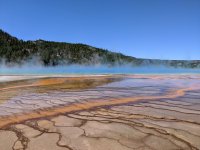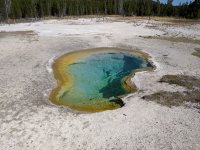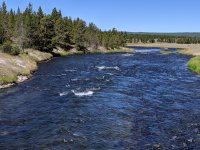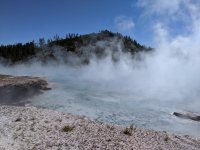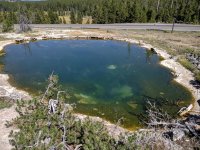I tried a bunch of different aperture binoculars a while back, and I came to the conclusion that the bigger the aperture, the better quality view you are going to get. So for the binoculars I don't use for hiking, I decided I liked an 8x56 and 10x56 the best. I bought an SLC 8x56, and optically it is one of the best binoculars I have ever used.
It doesn't have the huge FOV of the NL or SF, but it has better contrast, you can see into the shadows better, there are less optical aberrations because you are just using the sweet spot of the larger objective lens, it has much easier eye placement with the bigger EP and way fewer blackouts because of this, and it handles glare much better because with the bigger exit pupil because the glare never reaches your eyes which for me anymore is a priority. Even with the optical advancements of the NL and SF, they can't overcome the laws of physics and optics that stipulate a larger aperture is going to perform better than a smaller aperture.
Since I liked the SLC 8x56 so much I considered buying an SLC 10x56, but they are $2500 and not discounted too much, so accidentally I came upon a LNIB Zeiss Conquest HD 10x56 on eBay for $800 which is a great deal considering they retail for $1800. So I bought it, and frankly I wasn't expecting it too even compare with the SLC, but it surprised me how good it is. It is like a Zeiss Conquest HD 10x42 on steroids.
Everybody knows how good a Zeiss Conquest HD is, but the the 10x56 takes it to another level. It is shockingly bright, sharp and the contrast will knock your socks off. I almost think it is sharper on-axis than the SLC, although the SLC does have slightly sharper edges. Some reviewers have said the SLC has better CA control, but I think the Conquest HD is every bit as good at controlling CA.
It has an excellent smooth focuser, it is well-balanced and it is BRIGHT. The amazing thing about these big aperture binoculars is how they handle glare. You don't see ANY glare even near the sun. They are incredible the way they handle glare. These are not binoculars for the birder who does a lot of hiking, but they are more for static birding or when you walk a short distance to a stand or blind. You could carry them with a harness if you wanted to, and they wouldn't be too uncomfortable.
I had the Swarovski NL 10x42, and it has huge very good view and I paid about $2500 for mine discounted. The Zeiss Conquest HD 10x56 costs me $800, and it is bigger and heavier than the NL 10x42, but other than FOV and edge sharpness the Zeiss Conquest HD 8x56 beats the NL 10 x42 in ever other optical category including contrast, fewer optical aberrations, way better glare control, easier eye placement with fewer blackouts, it sees into shadows better, it has a more transparent and cleaner image, and it performs much better in low light.
I will say one thing once you get used to the view through these big apertures it is hard to go back to even a 42 mm.
" A basic and immutable law of optics is that, all other things being equal, (magnification, quality, engineering, etc.) bigger objective lenses will give you a brighter, more satisfying view than smaller lenses. They will yield more detail and better color rendition than you can possibly obtain from smaller objectives. Big objective lenses allow you to see more detail in deep shadows."
 www.audubon.org
www.audubon.org

 www.birdforum.net
www.birdforum.net
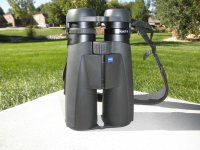
It doesn't have the huge FOV of the NL or SF, but it has better contrast, you can see into the shadows better, there are less optical aberrations because you are just using the sweet spot of the larger objective lens, it has much easier eye placement with the bigger EP and way fewer blackouts because of this, and it handles glare much better because with the bigger exit pupil because the glare never reaches your eyes which for me anymore is a priority. Even with the optical advancements of the NL and SF, they can't overcome the laws of physics and optics that stipulate a larger aperture is going to perform better than a smaller aperture.
Since I liked the SLC 8x56 so much I considered buying an SLC 10x56, but they are $2500 and not discounted too much, so accidentally I came upon a LNIB Zeiss Conquest HD 10x56 on eBay for $800 which is a great deal considering they retail for $1800. So I bought it, and frankly I wasn't expecting it too even compare with the SLC, but it surprised me how good it is. It is like a Zeiss Conquest HD 10x42 on steroids.
Everybody knows how good a Zeiss Conquest HD is, but the the 10x56 takes it to another level. It is shockingly bright, sharp and the contrast will knock your socks off. I almost think it is sharper on-axis than the SLC, although the SLC does have slightly sharper edges. Some reviewers have said the SLC has better CA control, but I think the Conquest HD is every bit as good at controlling CA.
It has an excellent smooth focuser, it is well-balanced and it is BRIGHT. The amazing thing about these big aperture binoculars is how they handle glare. You don't see ANY glare even near the sun. They are incredible the way they handle glare. These are not binoculars for the birder who does a lot of hiking, but they are more for static birding or when you walk a short distance to a stand or blind. You could carry them with a harness if you wanted to, and they wouldn't be too uncomfortable.
I had the Swarovski NL 10x42, and it has huge very good view and I paid about $2500 for mine discounted. The Zeiss Conquest HD 10x56 costs me $800, and it is bigger and heavier than the NL 10x42, but other than FOV and edge sharpness the Zeiss Conquest HD 8x56 beats the NL 10 x42 in ever other optical category including contrast, fewer optical aberrations, way better glare control, easier eye placement with fewer blackouts, it sees into shadows better, it has a more transparent and cleaner image, and it performs much better in low light.
I will say one thing once you get used to the view through these big apertures it is hard to go back to even a 42 mm.
" A basic and immutable law of optics is that, all other things being equal, (magnification, quality, engineering, etc.) bigger objective lenses will give you a brighter, more satisfying view than smaller lenses. They will yield more detail and better color rendition than you can possibly obtain from smaller objectives. Big objective lenses allow you to see more detail in deep shadows."
Size Matters: The Case for Really Big Binoculars
Size Matters: A Case for Really Big Binoculars Contrary to what some of us would like to believe size really does matter. Flight, for example, imposes strict limits on size. Ostriches...

World's Best 8X42: The Zeiss 8X56FL
The image provided by the best current binoculars looks so good that it’s easy to fall into the assumption that binoculars are now so close to optical perfection that further improvement wouldn’t accomplish anything as it would be invisible to the eye. Every now and then I disabuse myself of...

Last edited:








